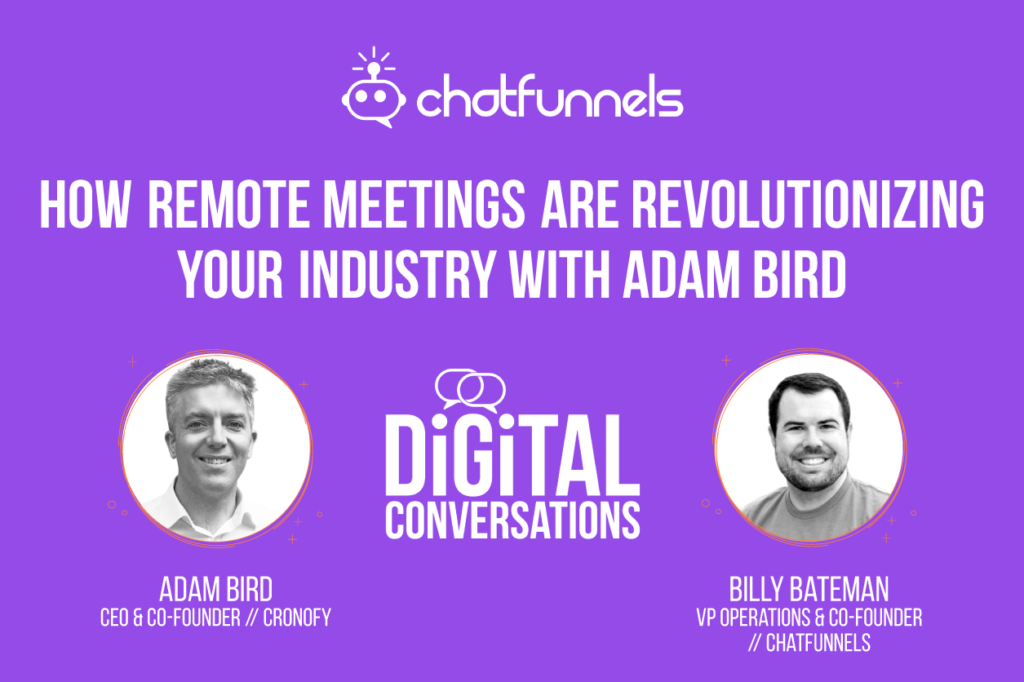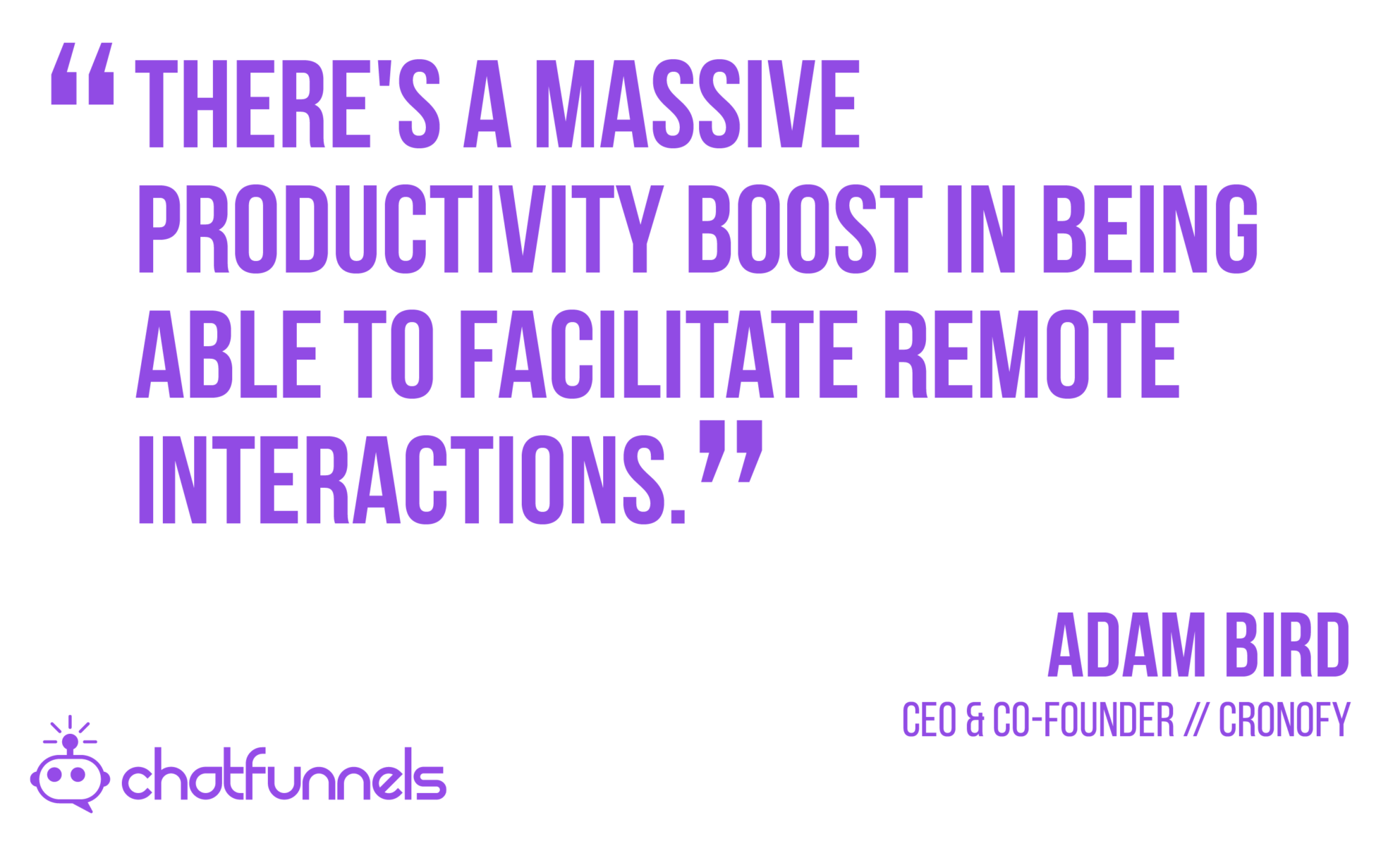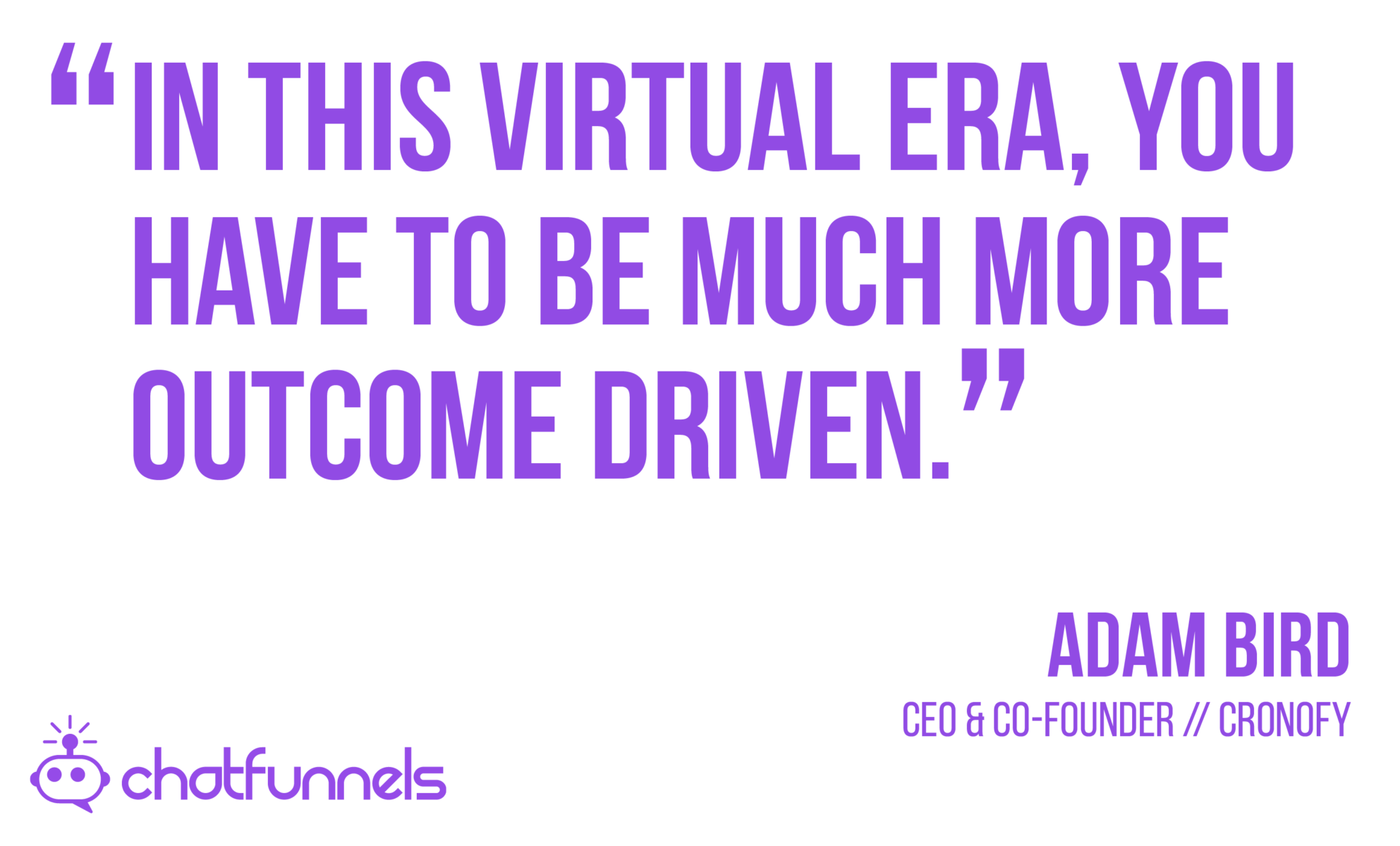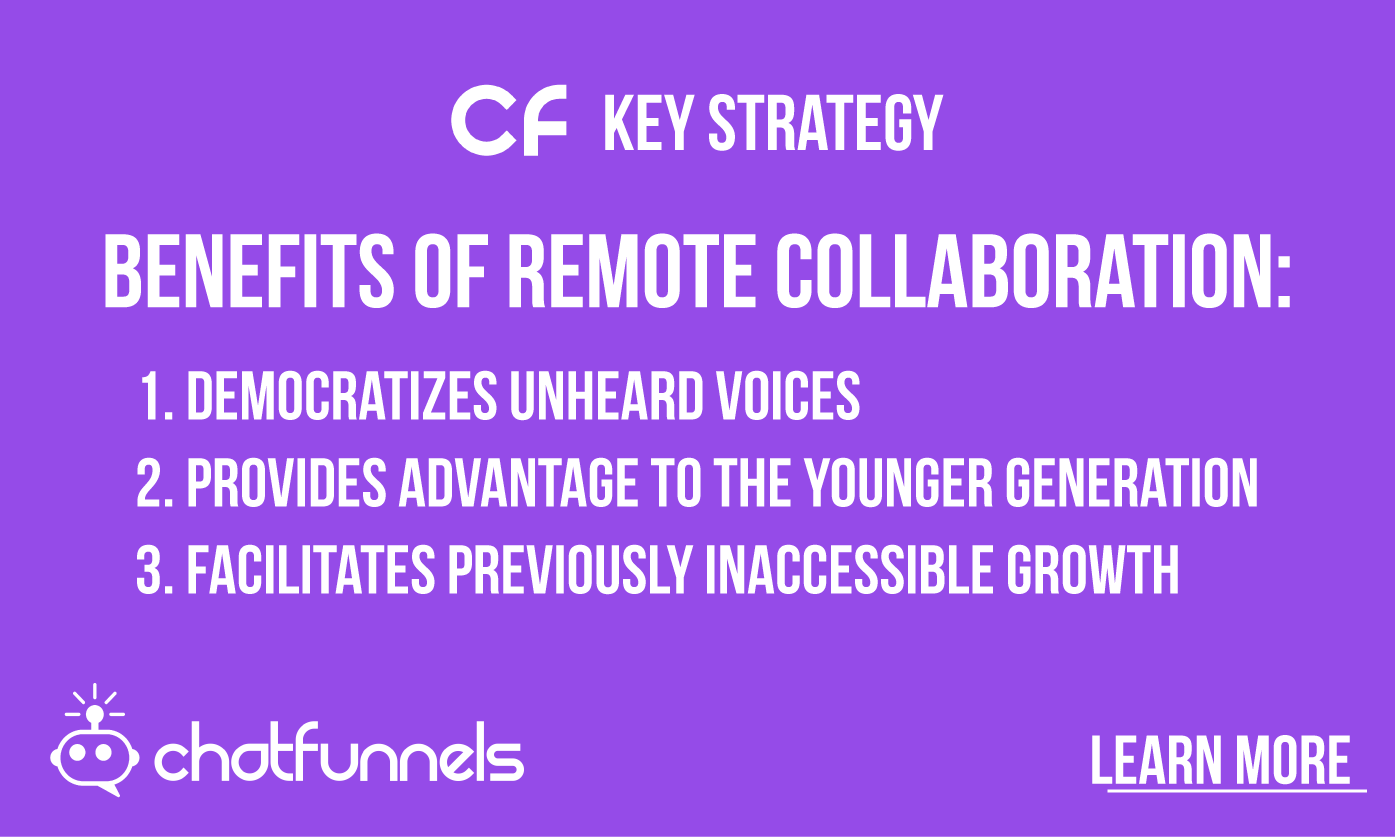How Remote Meetings Are Revolutionizing Your Industry

On this week’s episode of the Digital Conversations Podcast, Billy Bateman meets with Adam Bird, Co-Founder & CEO of Cronofy. Adam explains how many companies are finding a silver lining in this complicated work environment; especially when it comes to remote meetings.
Adam Bird: Adam has a long history of entrepreneurship and software development that has launched Cronofy into a very successful seven years of existence. He previously founded three other businesses, where he was able to leverage both his leadership and technical skills. Connect with Adam here!
Transcript
Billy: Alright, everyone, welcome to the show today. I’m your host, Billy Bateman. And I am joined by Adam Bird, co-founder and CEO of Cronofy. Adam. Thanks for joining us.
Adam: Great to be here.
Billy: Yeah, I’m excited for this. So, before we get into it, will you just tell everyone a little bit about yourself and Cronofy?
Introduction to Cronofy
Adam: So Cronofy is a scheduling infrastructure, think of Stripe for scheduling. So kind of organizations like GoDaddy, for example, uses us as a part of their website builder, you’re an SME and you want to take bookings online, you need to have calendar sync so they can find out when you when you’re available, we make all of that possible.
I’ve been a developer and entrepreneur since whenever I’ve been building, commercializing API’s since way before they were called probably about 2002 was when I started. So yeah, the gray hair is real.
Billy: Awesome. Awesome. So we’re actually customers of Cronofy it and use it. And and I love it. But I wanted to have this conversation. Because with COVID, and how the world has changed in the last six months, you guys have a unique perspective on seeing how businesses have gone to more of a remote aspect of dealing with their prospects, with their customers. And I’ll just open it up to you for just the trends that you’re seeing among people, the shift to remote.
Adam: Yeah, thanks. It’s, been fascinating. We’ve had a ringside seat in this transition, as well as trying to make sure we can provide the tools our customers need. So you sort of March, April time, we saw this a lot with US customers were okay, suddenly, we need conferencing, we need to make this happen. As an example, Houzz is a customer. And whereas before, they were scheduling, sort of face to face meetings with general contractors and designers and factories, so you could have your kind of dream, dream home build, suddenly, this had to be happening, this had to happen remote, and we had to kind of be able to facilitate that really quickly.
Then say, one of our other customers Iris Works, so they provide a solution for photographers, and photography studios, and these things had to happen, they have to happen face to face. The principle of photography is you’re kind of in the same place as someone. Especially with the kind of way photographers work. That is, the session after the photo session is where like the money is made. You go through, you pick your photos, and you kind of you cringe at some and love others and your partner likes the one that you don’t like all that kind of stuff happens.
But that all happens face to face. And suddenly they couldn’t do that face to face. So they’ve had to start to do that remotely. And what’s challenging, I think is it changes the whole buying process of people as well. So whereas you could pick up those cues and work out who was going to make the decision, trying to do that in a in a kind of remote sense, changes that the dynamic of that sales process immensely for those people?
Billy: I would think so, I would think so. So, I mean, obviously, we’re doing a lot more scheduling for remote meetings, across industries. I mean, we used to go out and visit our customers if they were close at least once a month, if we had to travel, usually quarterly. And we haven’t seen anybody. Yeah, since the first week of March, we were in New York to visit some customers and two or three days after we got home, they were shutting New York down. And that’s the last time we’ve traveled.
What do you think like with the Iris Works? How that transition going for companies like that, where they they’re like, okay, everything used to be face to face. And now I’m figuring out how to do it remote. What are some of the challenges you guys are hearing that they’re having?
Adapting to Remote Collaboration

Adam: I think you’d like to say it changes the nature of the interaction. And again, we see this with an interview as well. As social animals, we’re so used to taking cues around the way people hold themselves, the way people move. That kind of chit chat and discourse around things. It’s all part of the impression we’re building of people and certainly from any kind of sales process. That’s a social process anyway, as is an interview process. But I think the flip side is, the transition has happened so quickly because all of the tooling has been in place. Nothing’s kind of been invented in the last six months, that hasn’t been around for years. What happened is suddenly everyone’s had to deal with it. They’ve had to, it’s sink or swim.
Imagine if this had happened, say 10 years ago, I think we’d be in a very, very different position in terms of the pervasiveness of people having broadband at home. Yeah, just being able to work from home. I remember my last company, we had an office in early 2000s, had an office in Nottingham, in the UK and an office in Barcelona. And we tried to do kind of company meetings over Skype. And it was just awful. It was dreadful, we just gave up. In the end, it was just easier to get on a plane. Whereas now, I think it’s demonstrated that its force people to realize that actually, these things can happen, and actually kind of unlock some really interesting benefits. So we do a lot of work in the interview scheduling space.
So a lot of work with ATS, applicant tracking systems, and a really interesting chat one of our customers last week, so they provide the interview scheduling solution for the UK police force. Now, there’s been a big edict here, we need 20,000 more police officers, why would you need 20,000 more police officers? Well, because 20,000 were taken away. But anyway, we’re not going to go there. But what’s interesting is they have a kind of interview panel of up to 60 people, and they need three people from that panel. Now previously, these meetings happened face to face. So, there will be like, six people associated with this hiring center, six people with another.
So that we maybe have 10 hiring centers around the country. And so you were locked into when three of the six are available in your local hiring center. What go remote has changed, well, actually, we only need the 3 from 60, because actually people’s location is irrelevant now. So actually, you’ve got far more chance as a candidate to become a police officer of being able to find a time that’s tomorrow, the day after, because the kind of pool of people that they can be bringing is far greater.
So I think there’s a massive productivity boost in driving in able to facilitate these kinds of behaviors. What remains to be seen is whether or not we’ve learned how to hire, and whether or not we can kind of get around this social review we make have someone as part of the hiring process.
Billy: That’s interesting. I want to see how it how that plays out. Because we were hiring, we do you know, initial interviews, remote and over the phone or Zoom. And as of yet, I’m yet to trust myself enough to hire somebody without sitting down with them still.
Adam: We’ve done it. We shall see, but yeah, it’s a real leap of faith, absolutely.
But I also think there’s a challenge there in the kind of way we’re working as well. I think there’s a lot of people talking about the future’s remote, of course it’s amazing. And there are loads of benefits for one, no one has to be brilliant. For me, work is an inherently social activity. And I think, by working remote, what it has done is it kind of is snapped us away from the presenteeism way of judging whether people are doing their job.
It’s not whether they’re working late, you have to be outcome driven, you have to be looking at what actually what they’re creating. But the flip side of that, for me is and what I’m very conscious of with my team is, there’s a danger that it kind of dehumanizes the process as well, because you’re dealing with outcomes, and a zoom avatar, you’re not really dealing with a real person.
And it is very, very hard to kind of to make that into a 3d person that’s got all their other things that they’re doing. Because all of these little bits of chats we talked about when you come into and out of a meeting room and those kind of things. That’s all how you build up a picture of a person and understand the challenges and troubles of their own life, and the context in which they’re working.
Billy: For sure, there are a lot of benefits. But I think the hardest thing is exactly what you’re talking about, really getting to know your team for who they are as a person. I’m sure it’s possible, we’ll figure out a way but we’re gonna have to learn how to do that.
Adam: And I think also as you as you hire while we’re on the subject of hiring, I think hiring junior people is gonna be really hard this way. Because the kind of natural, it would be like apprenticeship type approach, where you kind of have you someone takes them under their wing, and they kind of they look after them and coach them and they’re there asking questions. That might suit a specific kind of personality type or a specific role type where they’re able do that.
But I think you could be missing out on a massive amount of talent who wouldn’t feel confident enough to raise their hand on Zoom or on Slack or whatever. You get that feeling whether someone’s struggling when you’re training them, and that sixth sense kicks in, and so you can help them ahead of the meeting to call up.
Billy: Yeah, I agree on that. My wife, where she works, is 100% remote right now. And right before COVID, they had a lot of turnover, had just hired I think six or seven new people on the her team. And she says she spends most of her day now proactively reaching out to all of these junior people to make sure they have what they need to train them. She’s like, I wish I was in the office, because they would probably just come over to my desk and say, Hey, Chelsea, can you help me with this?
And just look over their shoulder back? Oh, I can help you with that very quickly. But she’s just learned, Hey, I just have to be very proactive and reaching out to everybody. And once they learn it will they will be good. So, one other thing we we talked about that I want to make sure we don’t we don’t miss is virtual conferences. You had some interesting insights on that, that I want to make sure that you can share with everybody.
Virtual Conferences
Adam: Yeah, okay. So, yeah, I’ve done a few virtual conferences now. And both as a speaker and as an attendee, the speaker thing’s really hard, really, really hard. You’re just kind of speaking into the abyss and no one’s responding. And there’s no feedback at all that, that.
Billy: Were the live virtual conferences all recorded?
Adam: I’ve done both. So record is easier, because there isn’t that pressure. I fluffed that or I don’t mind, I can just record that again. Yeah, the live ones are, are brutal, I think, because it is that kind of like stand up comedians, talking about dying on stage, because like, you can hear a pin drop. And it’s like, it’s kind of that but you’ve set yourself up for it. But I’ve seen a couple of really good examples. So the Business of Software Conference, they’ve, kind of gone all in and really immerse themselves into trying to work out what makes a great conference. And one of the things they’ve done particularly well is that they do these constrained workshops, where as part of the process, the speaker then comes in, you have up to 16 people. So you can see everyone in a Zoom window.

And everyone can interact. But where I thought it was really interesting was on their kind of main speaker stage where, you have like 150 people were kind of watching. And after a talk from a speaker. You can often go down to the front and go up and ask them your question. And then you’re like, oh that’s just a cue. You can’t understand what’s being said. And you kind of think they obviously haven’t got much time. But what they did with this one was actually. Because the speaker just almost stayed in the room. Then everyone could hear the questions that were being asked.
And it feels like the auditoriums shrank, to exactly the number of people that are in the room, so it got down to like six people, seven people, five people, and all the time you could participate in the conversation. So, if the person asked a question that was essentially yours, or very similar to yours, you could interject to that point, that was fine. And everyone got benefit from that. And then you could then walk away and the auditorium shrunk again. It made for a really democratic process to actually engage with these people who are experts in their field.
I think especially in that situation, where, frankly, some people are quite shy, they can get real benefit from this, but actually walking down to the bottom of the auditorium standing in a queue. That pressure is building all the time. Then it that democratization of that interaction, I thought was really, really powerful. And the kind of shrinking of the auditorium, make it a unique experience, which I think was something that I wonder how you do that in real life.
Billy: Yeah, no, that’s awesome. I like that idea. You know, we had a virtual conference last month. And overall I was like, I was blown away with how well our team did and how well the event went. But more interaction between the speakers and the attendees is something that I came away thinking we’ve got to figure out how to do this at the next one more even just among the attendees themselves, because it was essentially, we’ve all done this, you log in, you can see the speakers, you can choose which ones you want. It’s great, but I think the next step is figuring out how to figure out a great way that attendees can connect with each other and with the speakers during the event, whether it’s live or recorded.
Adam: And I think it’s making that suit that context, that virtual context, not trying to recreate. I did one recently, and they kind of just let you network, you hit a button, and suddenly, you’re just speaking to a random person. And it’s like, you know what, I know whereas with business and software, they kind of put you in groups. So they just have breakout rooms of up to five people, and so you’re automatically assigned. You could choose not to not to join the room or to mute, but actually, because there were like four or five people in there, at least one person was going to start talking.
And you can kind of listen in, and kind of breaks that ice. There’s always someone who’s about a bit more confident. And that you kind of got trained to do that as part of that process. So that was really good. Although, I think the first couple of times they did it, they gave us like two minutes or something. Just when like the third person got going, it was like time to go back. So they learned very quickly and extended that out throughout the rest of the conference.
Billy: Cool. That’s interesting. I like it, I like it. And then one other thing I wanted to make sure we hit on was, you were talking you were talking about your sons and how they’re in different school years, and how things have changed for them.
The Next Generation

Adam: So my sons are in adjacent school years, so they’re always apart. But one is really young in the year, one’s very old in the year. And so my eldest went to university last year, and my youngest went to university this year. And what was fascinating for me, and as I think about the kinds of people we’ll be hiring in the future, in sort of three, four years time, when they graduate, is how they’re kind of transitioning to university life and their friendship groups has been changed by the pandemic. So my eldest, yeah, they’re all doing kind of WhatsApp groups or Facebook. But it was kind of minimal interactions. So you had your kind of subject groups, and you’re kind of whole groups and all that kind of stuff. And but really, kind of everyone was just waiting until they met up.
And you kind of maybe met someone who might have some kind of shared interest. But it was pretty low touch. To my youngest this year. So everyone knew it was going to be a bit weird that they were going to go in there. And actually he is under isolation at the minute because one of his flat mates tested positive. So he’s kind of in that isolation mode right now. But because essentially the world moved to Zoom. And this not just kind of one to one communication over video. But kind of group communication over video. It was essentially doing multi person video calls every night on the lead up to it, multiple groups.
It’s almost like that, they decided to sort of step over all the chat bit and just go straight down. We’ll just hang out for a few hours just chatting and getting to know each other. What he’s done is kind of hit the ground running in terms of his social group. And the kind of people he knows and people who’ve got shared. Shared hobbies with and experiences with them, that kind of thing. But also, as I kind of think about what that means for work. There’s a whole cohort of people now, for whom these kind of virtual worlds that we’ve created. We hear a lot about Oculus, and VR and AR and this kind of thing.
And honestly think that actually, we are now operating in virtual worlds. Zoom, Teams, Hangouts, they are virtual worlds. They are, we can see into other people’s real worlds, but really, they’re just an avatar, just a view on those worlds. And so the adoption of these kind of technologies in this way of working and back to my kind of question about hiring junior people, whether or not this whole cohort of people will just be completely comfortable operating in these virtual worlds.
And the role of work in their social life, may well not be as important to people of our generation. For me, work’s a social thing. I like being with the people I work with, that’s part of the reason I do my job. Is that going to be the same? When you can have a kind of virtual life at work and a real life at home?
Billy: Yeah. Yeah, that’ll be interesting to see. I think the younger generation will adapt really quickly to this. I don’t know if it’s for the better or the worse. We’ll see.
Adam: This is the thing, and you kind of look better history around you. It’s all these things that are kind of polluting young people’s minds. Video games from our generation. But you know what I mean. There’s always the kind of the descendants of the next generation it’s because of some technological shift or some pastime. And actually, everyone’s been kind of thrown into this mixer and forced to having to deal with these things. It will be interesting to see the kind of long term change and how we can we can work with and hire people and, and yeah, work hard to sell to people really that and that everything that we kind of used to do face to face. What’s going to change now?
Billy: Yeah. Awesome. Okay, Adam. Well, I appreciate it. Appreciate the time, and if people want to connect with you, what’s the best way for them to get hold of you?
Adam: So I am on LinkedIn, Adam Bird, to @Adambird on Twitter. Or check out Cronofy? Yeah, I’m happy to talk.
Billy: Okay, awesome, Adam. Thank you, and we’ll chat later.
Adam: All right. Thanks, Billy.

